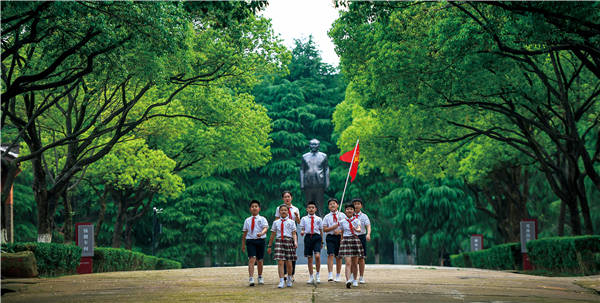

Jiangxi province hosts cities and rural settlements that were crucial to the operations of the Party and Red Army in the early 20th century and remain important to public education today, report Cheng Yuezhu in Beijing and Wang Jian in Nanchang.
Jiangxi province has long been a landmark of the Communist Party of China's revolutionary movements. It's home to a slew of historical sites and educational institutions where the stories of leaders and martyrs of yore are still told.
Its major cities, including its capital Nanchang and county-level cities Jinggangshan and Ruijin, have remained iconic red-tourism destinations, drawing visitors from around the country and the world to learn about the revolutions and zeitgeist of the early 20th century.
Nanchang
Nanchang, a city with a history of over 2,000 years, hosted the founding of the People's Liberation Army with the monumental Nanchang Uprising on Aug 1, 1927.
The CPC had endured the Kuomintang's political purges earlier that year, and decided to engage in armed resistance.
A revolutionary force led by He Long arrived in Nanchang in late July of 1927.
The Jiangxi Grand Hotel was turned into a command center, and a CPC front-line committee headed by Party leader Zhou Enlai was established.
Under the leadership of military strategists, including Zhou, He, Ye Ting, Zhu De and Liu Bocheng, the uprising began at 2 am on Aug 1.
Thousands from the opposing side were defeated after more than four hours of combat.
The revolt marked the beginning of the CPC independently leading an armed revolution and establishing its own army.
In commemoration, the date is designated as the national Army Day, and the Chinese characters for Aug 1 are printed on the military flag.
The Jiangxi Grand Hotel has been preserved as a part of the Nanchang Aug 1st Memorial Hall.

The city has more than 30 red-tourism destinations, says Xu Kai, a representative of Nanchang's culture bureau.
"Our city has created a number of well-known red-tourism destination brands," Xu says.
"The Nanchang Aug 1st Memorial Hall and the Nanchang New Fourth Army Exhibition Hall are national-level 4A scenic areas. And the Xiaoping Path scenic area is rated 3A and, following renovations, is applying for 4A status."
Much investment has been made to preserve historical relics and upgrade visitor experiences.
The local government has invested nearly 50 million yuan ($7.72 million) to restore sites related to the Nanchang Uprising and improve their security, and fire-and lightning-protection facilities.
The museums have adopted such technologies as virtual reality and augmented reality to provide immersive experiences for viewers of different age groups and cultural backgrounds.